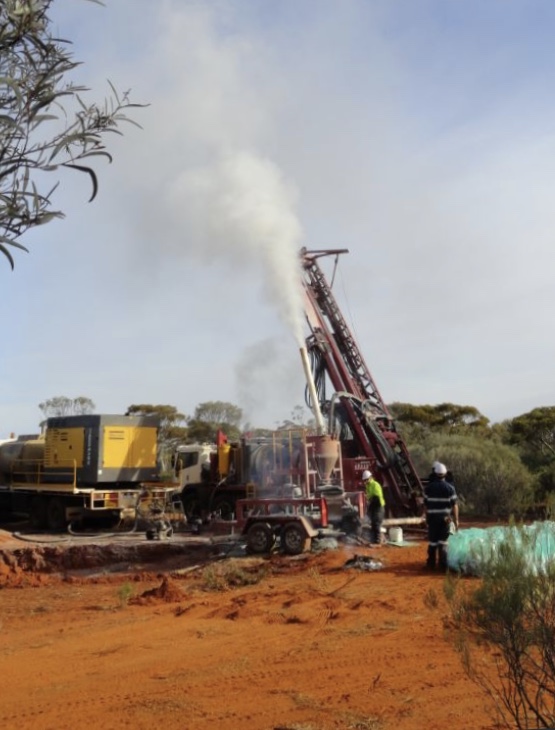This respected mine builder has no doubt Apollo’s Lake Rebecca will make the grade

Pic: Bloomberg Creative / Bloomberg Creative Photos via Getty Images
Special Report: Tony James knows what it takes to make a successful mine; he’s been intimately involved in building several new ones and resurrecting old ones over the course of a long career as a mining engineer.
And based on that experience, he is confident Apollo Consolidated’s Lake Rebecca Gold Project, 150km east-north-east of Kalgoorlie in the Western Australian goldfields, has all the necessary attributes.
James, the former chief operating officer of Avoca Resources and managing director of Mutiny Gold and Atherton Resources, joined Apollo (ASX: AOP) as a non-executive director in April 2018 after being approached by managing director Nick Castleden, a former colleague from his MPI Mines days.
In conducting his due diligence prior to accepting Castleden’s offer, James concluded that the Rebecca deposit, which is the centrepiece of the Lake Rebecca project, was one of better discoveries made in WA in recent years.
“When I joined, it was clear to me that this was a standout exploration project, albeit at a very early stage,” he tells Stockhead.
“It looked like a classic goldfields orebody. The big question was how do we turn it into a mine.
“Over the past two years, it’s become clear that this is definitely a project, it’s a mine that will be developed. But it is still early days.”
In the case of most gold discoveries, it is the low grade “halo” of mineralisation that companies strike on first before honing in on the higher grade core of the deposit.
With Rebecca, it was the other way round.
In August 2017, the first diamond hole drilled into the Laura lode at Rebecca returned intercepts of 17.84m at 15.95 g/t Au from 142m and 49m at 4.57 g/t Au from 166m.
This unusual sequence of events gave James the initial impression that the project was more likely to be developed as an underground mine.
Now though, it looks like it will start as a large open pit before morphing into an underground operation.
James views having a higher-grade component to the ore body, as Rebecca does, as important for the success of any mining operation.
“What I’ve learnt over the years is you need to be able to offset bad production days with good production days,” he says. “That’s what a higher-grade component allows you to do.
“It’s why I really like the project. If you have low grade and high grade within the dataset, you have a better chance of making a go of it.”
In February, Apollo announced a maiden resource for Lake Rebecca of 27.1 million tonnes at 1.2 g/t Au for 1.035 million ounces, with 53% of the ounces in the indicated category.
The Rebecca deposit provides 775,000 ounces at 1.3 g/t Au, while the satellite Duchess and Duke deposits provide 180,000 ounces at 1.0 g/t Au and 80,000 ounces at 1.1 g/t Au respectively.
James sees as an immediate priority increasing the level of confidence in the resource through further drilling.
“And there’s a lot of exploration that can be done concurrently with that” he adds.
“I really think this is the discovery of a new field, a new camp.”
As Castleden has stated, there is no rush to start mining studies at Lake Rebecca until there is a clearer picture of what the geology can provide.
The project’s untapped potential was highlighted in mid-May when Apollo reported hits of 25m at 1.23 g/t Au and 15m at 1.40 g/t Au from a hole drilled at a new prospect 1.2km north-east of Duchess.
The company has also been focusing on extending the mineralisation at depth below the existing resource at Rebecca and has had early success that supports the case for the mine proceeding underground.

There is no question Apollo is well capitalised to continue its exploration programs and when the time is right and the appropriate analysis has been done, commence studies.
At the end of March, it had $16.6 million in cash and is due to receive an additional US$4.5 million following completion of the sale of its 20% interests in the Liberty and Bagoe gold projects in Cote d’Ivoire.
Despite the satisfaction he gets from building mines – and in particular from seeing the benefits flow through to local communities and the industry – James understands that potential corporate transactions need to be assessed as well.
“I think you’ve seen with me that I’ve been prepared to move things on if the overall benefit to the community and the shareholders will be realised,” he says.
James was in charge of Atherton Resources in 2015 when the company accepted a $56 million takeover offer from Auctus Minerals and was managing director of Mutiny Gold in 2014 when it merged with Doray Minerals.
Along with his role at Apollo, he is a non-executive director at Galena Mining (ASX: GLA) and Blackham Resources (ASX: BLK).
This story was developed in collaboration with Apollo Consolidated, a Stockhead advertiser at the time of publishing.
This story does not constitute financial product advice. You should consider obtaining independent advice before making any financial decisions.
Related Topics

UNLOCK INSIGHTS
Discover the untold stories of emerging ASX stocks.
Daily news and expert analysis, it's free to subscribe.
By proceeding, you confirm you understand that we handle personal information in accordance with our Privacy Policy.







